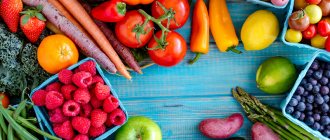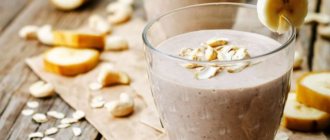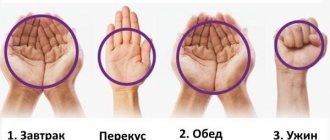General information
The term “human nutritional standards,” which is very often used in medical literature, is in fact not entirely accurate. Many nutritionists argue that it is more correct to use the concept of “physiological needs of the body,” because the most important thing is the body’s need for the most important nutrients. Currently, there are many recommendations regarding food consumption standards. Below we will discuss the most important of them, which will help you correctly determine nutritional standards and develop the healthiest diet possible.
How many times a day should you eat to gain weight?
It also doesn’t matter how many times a day you eat to gain weight. The main thing is the amount of calories and food. Another point is that people whose diet contains a lot of calories get full quickly. In this case, frequent snacking will help you eat more.
Studies done on athletes show that body composition improves with frequent meals. Protein is well absorbed in the amount of 20 - 30 g at one time. And a large number of calories is difficult to fit into three servings of food.
Read also: What can you eat before bed?
This is interesting! Professional bodybuilders consume up to 9 thousand calories and eat 7 - 9 times a day.
To gain muscle mass, eat 6 meals a day at intervals of 2 to 3 hours. The main meal is breakfast and before training. After exercise - a recovery meal, a light dinner.
Advantages:
- With a low-calorie diet, less lean muscle mass is lost;
- anaerobic power increases;
- fat utilization improves.
How are nutrition standards determined?
Back in 1930, nutrition standards for humans were determined in Russia. Later, already in 1991, these standards were established taking into account the coefficient of physical activity (this is the ratio of daily energy expenditure to the value of the main volume). Also an important point in the calculation is the calorie ratio between carbohydrates, proteins and fats - it should accordingly be 50:15:35. When physiological norms are calculated, other important points are taken into account - age, gender, physical activity, the presence of chronic diseases, etc.
The daily calorie intake for women is 2100, while the men's diet should contain 2700 calories. If a person works physically, these indicators increase. Accordingly, for those losing weight, the calorie content of the daily diet should be reduced. For children, these indicators are already associated with the intensity of their growth and activity.
Nutrition standards have also changed historically, as changes occurred in human living conditions. When he had to fight for survival, hunt a lot and get food, the calorie intake was much higher in order to survive and replenish energy costs. However, in the modern world, people tend to consume much more than they spend. Now there is every opportunity to eat both varied and tasty, but at the same time both the quality of food and the balance of the diet as a whole are deteriorating. This leads to illness, obesity, and a general deterioration in the quality of life.
Thus, nutritional standards for a person differ depending on the following factors:
- floor;
- characteristics of work;
- age;
- climate;
- physiological state of the body - pregnancy , lactation, diseases, etc.
It is important to consider that the body may require different amounts of calories on different days. After all, metabolism can slow down and speed up at different times.
In addition, it depends on physical activity, work performed, and other external factors. So you don't have to count calories too carefully. It is important to simply adhere to the recommendations for proper nutrition, and not significantly violate the standards determined by nutritionists.
How many grams should a serving be with proper nutrition for weight loss?
Start cutting down to healthy portions and your body will become one too. Check food labels and restaurant menus for hidden calories. Learn to “eyeball” your food, determining how many grams a serving of food should be with proper nutrition.
Reduce your plate size to lose weight. Perhaps we all grew up in an environment where we were told while eating: “The plate must remain empty.” The problem is that dinner plates in homes, as well as in restaurants, have gotten larger, and so has the amount of food we put on them; If you empty your plate now, you'll probably overeat.
- Use salad bowls.
- Eat from a smaller dish using salad bowls.
- Study and serve the correct serving size.
- Don't leave extra food on the table that might tempt you.
- Store leftovers in disposable fast food containers.
Eating out? A few tips on how many grams a serving should be for a healthy diet:
- Restaurants usually serve one person enough food for two or three, but you don't have to eat it all; You can order half a portion or something from the children's menu.
- If you order a full-size dish, pack half of it before you start eating, or split the dish with a friend.
- Eat a healthy appetizer and soup or salad instead of your main course.
Daily diet
How many calories you should consume depends on your age, gender, and activity level. A moderately active woman should have 1800-2200 calories per day, an active man of average height should have 2200-2800 calories. Have a healthy balance of foods every day by knowing your serving size in grams when eating healthy:
- 1 1/2 – 2 ½ measuring cups fruits and 2 1/2 – 3 ½ measuring cups vegetables.
- 170 – 280 g bread, 1/2 whole grains.
- 3 cups low-fat or low-fat dairy products.
- 140 – 200 g protein (meat, beans and seafood) every day.
- No more than 5-8 teaspoons of oils, mainly from plants, fish and nuts.
- 170-400 calories from solid fats and sugars.
Learn to look at portion sizes. To determine your portion size when eating healthy for weight loss in grams, you don't have to weigh or measure your food every time you eat - instead, keep a mental image of a deck of cards, a poker chip, a baseball, a hockey puck, a CD, dice and light bulbs; this will make it easier to introduce healthy portion sizes.
Measure your foods regularly to get an idea of what serving sizes are appropriate for a healthy diet. It becomes easier to select the appropriate volume as you become more used to it. While portion sizes are a valuable tool, it's important to listen to your body while eating: if you're still hungry after eating one portion, it likely means you need more food; and if you feel full from less than one serving, that’s also normal.
Overcoming portion violations
It's easy to mistake a larger portion for better value. To overcome the bias and reduce your portion sizes, try the following:
- Read the label. Nutrition facts on the label can help determine appropriate serving size.
- Eat from a plate, not from a package. It's easy to eat more than one serving when eaten straight from the box or packaging. Portion your food first and remove packaging before you eat to keep portion size under control.
- Use the right tools. Try separating foods with measuring cups and spoons to give yourself an idea of what serving sizes look like. Small plates and bowls can also make portion sizes appear larger and leave you more satisfied.
What does balance depend on?
The energy that enters the body depends on the amount of food consumed and their composition. Energy supply depends on the following factors:
- calorie content of food;
- composition of products;
- vitamins;
- micro- and macroelements;
- liquid.
In turn, energy is spent on supporting vital functions - heat exchange, blood circulation, cell growth and renewal, and the process of food digestion. It is also spent on movement and physical activity.
The body's need for food products
For the body to function normally, it must receive sufficient, and most importantly, a balanced amount of proteins, fats and carbohydrates. It is very important that food is environmentally friendly, although this is currently quite difficult to ensure.
Squirrels
They are the basis of human nutrition and life. You need to get proteins per day at the rate of 1 g per 1 kg of weight. These are minimum indicators, because a growing teenager should receive at least 5 g of protein per kilogram of body weight. A person gets proteins from meat, fish, dairy products, and legumes. After a full meal, up to 30 g of protein is absorbed within three hours.
In fact, proteins are a component necessary for the “construction” of the body and the production of all vital substances - enzymes , hormones , etc. It is with proteins that a person receives the so-called essential amino acids , which are not synthesized in the body. However, it is important to understand that excess protein can cause intoxication in the body.
Carbohydrates
The minimum requirement of carbohydrates per day is 300 g. The body receives carbohydrates by consuming fruits, vegetables, starches, and grains. Carbohydrates are the main “fuel” for the body, so their quantity largely determines a person’s condition. But if a lack of carbohydrates leads to disruption of metabolic processes, then their excess leads to the formation of excess fat. Excess weight gain occurs if more than 500 g of carbohydrates enter the body in one meal, as this leads to a sharp increase in glucose in the body, which leads to an increase in insulin and stimulation of the synthesis of fats, which are deposited in fat depots.
Fats
The absorption of fats in the body occurs during the consumption of protein foods. Fats are an essential element of a balanced diet. They are a source of energy and essential fatty acids. They are also important for the absorption of vitamins. The most important for the body are vegetable fats, consisting of unsaturated fatty acids. They do not contain cholesterol and are easily digestible. Animal fats are digested more slowly and contain a lot of cholesterol.
It is recommended to consume vegetable and animal fats in a 2:1 ratio. However, many modern nutritionists argue that the amount of animal fats can generally be reduced to a minimum.
Vitamins and minerals
In addition, dietary fiber, vitamins and minerals contained in food are important for the body. Basically, the body receives them from plant foods - greens, vegetables, fruits. Some of them contain a lot of fiber .
How does proper nutrition differ from dieting?
Proper nutrition is the only right solution to start the weight loss process. If you follow its principles, it is possible to lose 1 kilogram per week without causing harm to your health.
A person who decides to lose weight with the help of proper nutrition (hereinafter referred to as PN) should know that the main principle is no to diets.
What is a diet? These are strict restrictions in the daily diet, following which irreversible harm to health is caused. Some diets can even be called fasting. At this time, the human body does not receive the set of vitamins and microelements necessary for normal life.
Therefore, it is not surprising that those who are losing weight, in addition to a constant feeling of hunger, experience fatigue, malaise, and weakness. In this state, it may be impossible to concentrate on work and other matters, since the brain does not receive the necessary glucose.
In addition, sooner or later a so-called breakdown occurs, when a person on a diet opens the refrigerator and loses control over himself. First he eats the contents of the shelves, and then wonders how he could afford this. At the same time, all the lost kilograms come back, taking a couple more friends with them.
If you follow the PN regime, there is no need to impose strict restrictions on food, so the process of losing weight occurs naturally, without harming the body. The effect will be reflected not only in the mirror, but also in the form of a general improvement in well-being.
How to plan your diet correctly?
When shaping their diet, most people are guided by their own food preferences and needs. However, there are more specific guidelines by which a person’s daily nutritional intake can be formed. So, for a person per day or per week, in order to organize a balanced diet, the following products should be included in the menu (we are talking about a person of middle age and weight):
- Meat – 170 g daily. This amount includes both poultry and red meat. In this case, high-quality poultry meat should account for approximately half of this amount. It is quite acceptable for meat to not be on the menu every day. For example, you can eat it 4 days a week, 250 g.
- Fish - 300 g every week . Fish dishes can be eaten twice a week to ensure that the body receives enough nutrients. It is recommended to choose fatty fish, as they are high in omega-3 fatty acids , which are beneficial for health. The same standard includes any seafood.
- Vegetables – up to 400 g daily. This is the minimum you should consume daily. Almost every lesson on proper nutrition includes recommendations that the more vegetables included in the diet, the better it will be for your health. Every day you should prepare salads, eat boiled and stewed vegetables. However, it is important to understand that this norm should not be “overshadowed” by completely starchy vegetables - potatoes, beans, peas, beans.
- Fruits – up to 300 g per day. This amount is also only a minimum; it is advisable to eat even more fruit. We are talking, first of all, about fresh fruits, and not prepared in the form of jam or compotes. After all, fresh fruits have beneficial properties that are important for the body. However, recently prepared fruits, for example, baked in the oven, also retain a certain set of beneficial properties.
- Bread – up to 250 g per day. Since most people perceive bread as an independent product, it is often separated into a separate group. This norm should include all types of bread. It is especially important that a person regularly consumes whole grain bread. It is optimal for the main part of the diet to be bread with bran, while the amount of baked goods should be kept to a minimum.
- Cereals – 6 servings per day. Six servings is a plate of porridge or about 300 g of baked goods. We are talking about all cereals, pasta, and baked goods. In this case, the recommendations are similar to those regarding bread: it is important that this norm consists mainly of porridges made from unprocessed grains. It is advisable to consume different types of grains to get maximum benefits.
- Fats - at the rate of 1 g per 1 kg of weight per day. If a person weighs 70 kg, he should consume 70 g of fat per day. But in this case we are talking about fat consumed in general. That is, the one that is contained in different dishes and products also needs to be counted. The diet should contain both animal and vegetable fat, and it is better to consume more of the latter, but not less than 50% of the total amount of fat.
- Sugar – no more than 6 tsp. for women and no more than 9 tsp. for men. This does not mean that you need to put exactly this amount of sugar in tea or coffee. We are talking about sugar in general - that is, the sugar contained in foods and dishes must also be taken into account. It is important to remember that there is a lot of so-called hidden sugar in different dishes - it is found in baked goods, yoghurts, cereals, juices, etc. Those who cannot even approximately calculate the amount of sugar consumed should eat no more than 2 tablespoons of pure sugar per day. The rest of the person will receive from the dishes he eats throughout the day.
- Salt - up to 5 g per day. The amount of salt per day for a person is only one teaspoon. Moreover, the salt that is sprinkled on salads and the hidden salt is taken into account, that is, the salt that is in herring, sausage, snacks, etc. Salt should not be abused under any circumstances.
- Coffee – no more than 300 mg of caffeine per day. On average, this is the amount of caffeine contained in approximately 350 ml of ready-made natural coffee, provided that its strength is moderate. If the coffee is instant, then this is about 500 ml of drink. However, these are average recommendations. For some people this may be excessive. It is important to note that a certain amount of caffeine is also found in tea, especially green tea.
- Alcohol – 30 g of ethanol for men, 20 g for women per day. Of course, we are not talking about a recommendation, but only about an acceptable norm that will not cause harm to the body. The amount of alcohol depends on its strength. If we talk about dry wine, a woman can drink 200 ml of this drink, a man - 300 ml.
Introducing all of the listed products into the diet and observing calorie standards will make it possible to make the menu balanced and get all the substances necessary for the body in full.
Favorite foods that are calorie bombs
Most of our calories come from foods high in fat and sugar. Sweets such as cookies and cakes, along with yeast breads, top the list. We also get our fill of calories from chicken dishes (often breaded and fried), soda, energy drinks and sports drinks. Pizza, alcohol, pasta, and beef dishes accumulate more calories. Unless you count calories and know what portions should be for proper nutrition, the result can be quite disastrous.
Just two problem foods - solid fats and added sugars - account for about 800 of our daily calories, which is almost half of the calories the average woman should have in a day. Dietary guidelines say we should limit solid and saturated fats and eliminate trans fats entirely; Reduce your consumption of fast food and refined grains, such as white bread: being in such a mode of searching for options, what should be the portion of food for a healthy diet, it is also necessary to reduce sodium (salt). Most of us get too much, increasing our chances of high blood pressure and heart and kidney disease.
Add more nutritious foods to your diet:
- Instead of fatty meats, choose lean protein and seafood; Aim to eat at least 200g of fish per week.
- Instead of solid fats like butter or margarine, use olive, canola and other oils that are good for your waistline and heart.
- Instead of baked goods and cereals containing all white or refined grains, make at least half of them whole grains.
- Other healthy foods include low-fat or low-fat dairy products, eggs, beans and plenty of fruits and vegetables.











